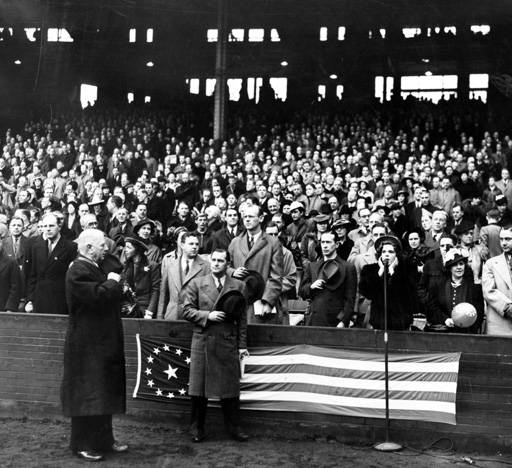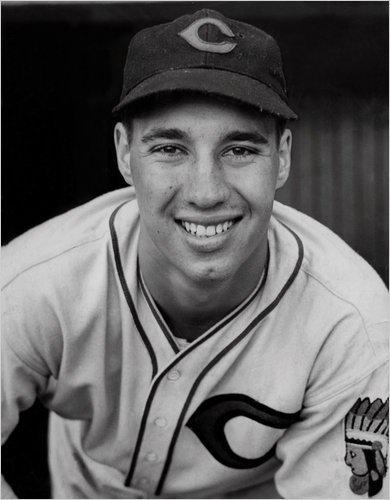April 21, 1939: Bob Feller makes his first Opening Day start in front of Judy Garland
 The Cleveland Indians were supposed to open the 1939 season on the road against the St. Louis Browns, but that three-game series was postponed after St. Louis was deluged with rain and, in some places, sleet.1
The Cleveland Indians were supposed to open the 1939 season on the road against the St. Louis Browns, but that three-game series was postponed after St. Louis was deluged with rain and, in some places, sleet.1
The return to Cleveland promised no better weather, with frigid temperatures and precipitation. In fact, it was a game-day decision to play the opener on a blustery Friday afternoon on the lakefront at Cleveland Stadium.
A crowd of 23,957, a little more than a quarter of the capacity of the cavernous stadium, was treated to an Indians win — and pregame entertainment from one of the greatest entertainers of the twentieth century.
Judy Garland, just 16 but already an experienced entertainer on stage and as a contract player for MGM, was in town to start a two-week engagement at the State Theatre on Euclid Avenue (part of what’s now known as Playhouse Square) that night. Her time in Cleveland included an appearance at the prom of the University School, an area prep school. The Cleveland Plain Dealer noted that her manager let her attend the prom “as Judy infrequently has the opportunity of going out socially with young people her own age.”2 Less than a month earlier, she’d completed principal filming on the movie version of L. Frank Baum’s book The Wizard of Oz.3
She attended the opener as a guest of Indians owner Alva Bradley,4 and had been invited to sing the national anthem, gamely posing for pictures beforehand — even donning an Indian headdress for a photo with Indians manager Oscar Vitt and his opposite number with the Tigers, Del Baker.5
With the band playing the anthem in the outfield and Ms. Garland in the owner’s box, she pressed her fingers to her ears to sing—she wanted to keep her own tempo. Cleveland Mayor Harold Burton threw out the ceremonial first pitch — badly, said the next day’s Plain Dealer, noting that “it struck the ground 15 feet in front of the plate”6 — and Cleveland finally got the season started.
Bob Feller made the first of his seven Opening Day starts, still as of 2019 a team record, even if he was a little rusty from more than a week of inactivity. “It’s been so long since I pitched an inning that I almost needed a compass to find the mound,” Feller said.7 He took the mound wearing not his new number 19, later retired by the Indians, but Mel Harder’s number 18, which the Tribe also retired.8 Indians business manager Frank Kohlbecker said many of the uniform numbers were changed because the printer put the wrong uniform numbers on the scorecard. The players changed shirts to avoid jettisoning 15,000 scorecards. “There was no explanation of how the printer happened to go completely haywire on his numerology and switch every player and coach’s number,” Ben Williamson said in the next day’s Cleveland Press.9
 Feller had last seen the Tigers in the previous season’s finale, in which he set a major-league record with 18 strikeouts. But he’d walked seven and ended up taking the loss. In the frigid 1939 opener, he struck out “only” 10 — but had better control, walking just Charlie Gehringer and Hank Greenberg in a 5-1 win. Feller combined his blazing fastball with a new changeup, and the Press noted that he got behind in the count on only five batters. “He had a dandy curve,” Greenberg said, “And you can’t hit the kind of stuff he was giving us.”10
Feller had last seen the Tigers in the previous season’s finale, in which he set a major-league record with 18 strikeouts. But he’d walked seven and ended up taking the loss. In the frigid 1939 opener, he struck out “only” 10 — but had better control, walking just Charlie Gehringer and Hank Greenberg in a 5-1 win. Feller combined his blazing fastball with a new changeup, and the Press noted that he got behind in the count on only five batters. “He had a dandy curve,” Greenberg said, “And you can’t hit the kind of stuff he was giving us.”10
The lone Detroit run came on Barney McCosky’s homer in the sixth inning, and that was only after a foul ball that catcher Frankie Pytlak chased to the edge of the grandstand landed in the stands after a fan pushed Pytlak. “This happens every now and then, and when it does, I say to the guy, ‘What the hell, what the hell?’ and most of ’em say right back to me, ‘Aw, nuts,’” Pytlak said in the next day’s Press. “But this guy was different. I say, ‘What the hell, why’s the push?’ and he astounds me. He says, ‘I’m sorry, Frankie.’ A nice guy, probably, and I ain’t sore at him.”11
Hal Trosky doubled twice, driving in two runs with one of them, and Skeeter Webb went 3-for-5 as the Indians scored single runs in the first and third innings and were in command all the way.
Garland became a major star after The Wizard of Oz, even winning a juvenile Academy Award the following year. But by the time the movie premiered in August, the Indians were already out of the pennant race, despite an optimistic preseason slogan, “World’s Fair in New York, World Series in Cleveland,” chosen by the Cleveland News.12 On the day the movie made its national premiere, August 25, the Indians were in fourth place, 21 games behind the American League-leading Yankees. Cleveland finished the season in third place with a record of 87-67, 20½ games behind the Yankees, who won the pennant and the World Series. Feller finished the season 24-9 with a 2.85 ERA and 246 strikeouts in 296⅔ innings. All three accomplishments led the American League.
Sources
In addition to the sources cited in the Notes, the author used the Baseball-Reference.com website for team and player pages and reviewed the game box scores at:
https://baseball-reference.com/boxes/CLE/CLE193904210.shtml
https://retrosheet.org/boxesetc/1939/B04210CLE1939.htm
Photo credit
16-year-old Judy Garland sings the National Anthem on Opening Day, April 21, 1939, at Cleveland Stadium. (CLEVELAND MEMORY PROJECT)
Notes
1 George Kirksey, UPI, “Yankees Annex Season Opener from Red Sox,” News-Record (Neenah, Wisconsin), April 21, 1939: 4, reporting that through April 21, neither the Indians nor Browns had played their first games of the season.
2 “Society’s Whirligig,” Cleveland Plain Dealer, April 30, 1939: B1.
3 thewizardofozmovie.com/movie.html.
4 “Swingsters to Visit State Friday,” Cleveland Plain Dealer, April 18, 1939: 14.
5 judygarlandnews.com/2018/04/21/on-this-day-in-judy-garlands-life-and-career-april-21/.
6 “Shivering 23,957 See Tribe Win, 5-1,” Cleveland Plain Dealer, April 22, 1939: 15.
7 Eugene J. Whitney, “Averill Calls It Bob’s Best Game,” Cleveland Plain Dealer, April 22, 1939: 16.
8 Feller had worn number 9 during his 1936 debut season and number 14 in both 1937 and 1938. He switched to number 19 for the rest of his career.
9 Ben Williamson, “Scrambled Indians Please Their Boss and Fans and Pytlak Finds ‘a Nice Guy,” Cleveland Press, April 22, 1939.
10 Ibid.
11 Ibid.
12 Scott Longert, Bad Boys, Bad Times: The Cleveland Indians and Baseball in the Prewar Years, 1937-1941 (Athens, Ohio: Ohio University Press, 2019), 109.
Additional Stats
Cleveland Indians 5
Detroit Tigers 1
Cleveland Stadium
Cleveland, OH
Box Score + PBP:
Corrections? Additions?
If you can help us improve this game story, contact us.

